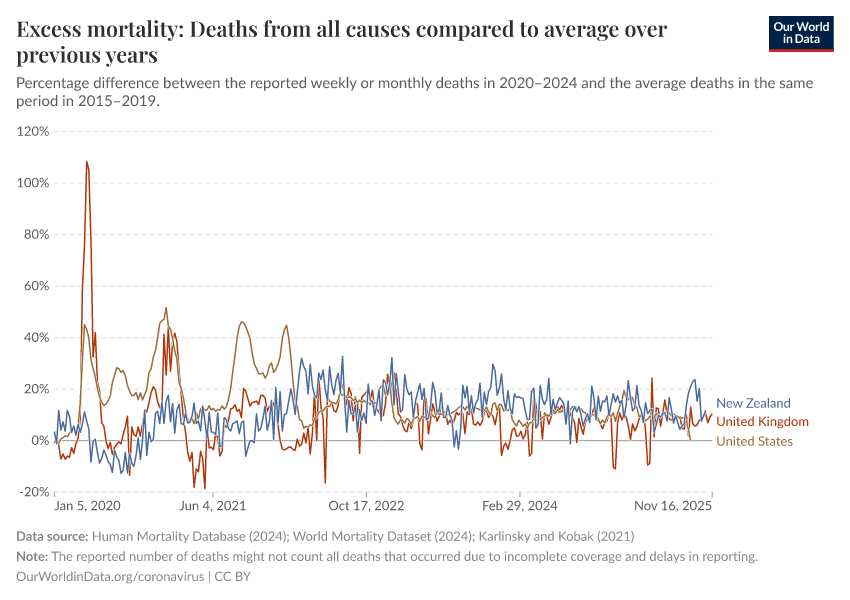Excess mortality: Deaths from all causes compared to average over previous years

What you should know about this indicator
- Excess deaths is estimated as Excess deaths = Number of reported deaths - Number of expected deaths. Excess mortality goes beyond confirmed COVID-19 fatalities by capturing all deaths above a projected baseline, including indirect deaths from pandemic-related disruptions.
- All-cause mortality data is from the Human Mortality Database (HMD) Short-term Mortality Fluctuations project and the World Mortality Dataset (WMD). Both sources are updated weekly.
- We use the baseline estimates by Ariel Karlinsky and Dmitry Kobak (2021) as part of their World Mortality Dataset (WMD).
- We do not use the data from some countries in WMD because they fail to meet the following data quality criteria: 1) at least three years of historical data; and 2) data published either weekly or monthly. The full list of excluded countries and reasons for exclusion can be found in this spreadsheet.
What you should know about this indicator
- Excess deaths is estimated as Excess deaths = Number of reported deaths - Number of expected deaths. Excess mortality goes beyond confirmed COVID-19 fatalities by capturing all deaths above a projected baseline, including indirect deaths from pandemic-related disruptions.
- All-cause mortality data is from the Human Mortality Database (HMD) Short-term Mortality Fluctuations project and the World Mortality Dataset (WMD). Both sources are updated weekly.
- We use the baseline estimates by Ariel Karlinsky and Dmitry Kobak (2021) as part of their World Mortality Dataset (WMD).
- We do not use the data from some countries in WMD because they fail to meet the following data quality criteria: 1) at least three years of historical data; and 2) data published either weekly or monthly. The full list of excluded countries and reasons for exclusion can be found in this spreadsheet.
Sources and processing
This data is based on the following sources
Human Mortality Database; World Mortality Dataset (2024); Karlinsky and Kobak (2021)
HMD. Human Mortality Database. Max Planck Institute for Demographic Research (Germany), University of California, Berkeley (USA), and French Institute for Demographic Studies (France). Available at www.mortality.org.; Karlinsky & Kobak 2021, Tracking excess mortality across countries during the COVID-19 pandemic with the World Mortality Dataset, eLife https://doi.org/10.7554/eLife.69336; Karlinsky & Kobak, 2021, Tracking excess mortality across countries during the COVID-19 pandemic with the World Mortality Dataset. eLife 10:e69336. https://elifesciences.org/articles/69336
How we process data at Our World in Data
All data and visualizations on Our World in Data rely on data sourced from one or several original data providers. Preparing this original data involves several processing steps. Depending on the data, this can include standardizing country names and world region definitions, converting units, calculating derived indicators such as per capita measures, as well as adding or adapting metadata such as the name or the description given to an indicator.
At the link below you can find a detailed description of the structure of our data pipeline, including links to all the code used to prepare data across Our World in Data.
Reuse this work
- All data produced by third-party providers and made available by Our World in Data are subject to the license terms from the original providers. Our work would not be possible without the data providers we rely on, so we ask you to always cite them appropriately (see below). This is crucial to allow data providers to continue doing their work, enhancing, maintaining and updating valuable data.
- All data, visualizations, and code produced by Our World in Data are completely open access under the Creative Commons BY license. You have the permission to use, distribute, and reproduce these in any medium, provided the source and authors are credited.
Citations
How to cite this page
To cite this page overall, including any descriptions, FAQs or explanations of the data authored by Our World in Data, please use the following citation:
“Data Page: Excess mortality: Deaths from all causes compared to average over previous years”. Our World in Data (2025). Data adapted from Human Mortality Database, World Mortality Database. Retrieved from https://archive.ourworldindata.org/20251230-063258/grapher/excess-mortality-p-scores-average-baseline.html [online resource] (archived on December 30, 2025).How to cite this data
In-line citationIf you have limited space (e.g. in data visualizations), you can use this abbreviated in-line citation:
Human Mortality Database; World Mortality Dataset (2024); Karlinsky and Kobak (2021); Human Mortality Database (2025); World Mortality Database (2024) – processed by Our World in DataFull citation
Human Mortality Database; World Mortality Dataset (2024); Karlinsky and Kobak (2021); Human Mortality Database (2025); World Mortality Database (2024) – processed by Our World in Data. “Excess mortality: Deaths from all causes compared to average over previous years” [dataset]. Human Mortality Database, “Human Mortality Database”; World Mortality Database, “World Mortality Database” [original data]. Retrieved December 30, 2025 from https://archive.ourworldindata.org/20251230-063258/grapher/excess-mortality-p-scores-average-baseline.html (archived on December 30, 2025).